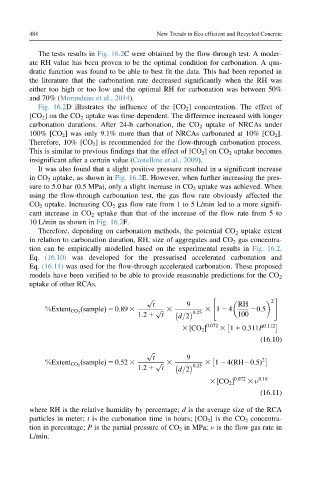Page 536 - New Trends in Eco efficient and Recycled Concrete
P. 536
484 New Trends in Eco-efficient and Recycled Concrete
The tests results in Fig. 16.2C were obtained by the flow-through test. A moder-
ate RH value has been proven to be the optimal condition for carbonation. A qua-
dratic function was found to be able to best fit the data. This had been reported in
the literature that the carbonation rate decreased significantly when the RH was
either too high or too low and the optimal RH for carbonation was between 50%
and 70% (Morandeau et al., 2014).
Fig. 16.2D illustrates the influence of the [CO 2 ] concentration. The effect of
[CO 2 ] on the CO 2 uptake was time-dependent. The difference increased with longer
carbonation durations. After 24-h carbonation, the CO 2 uptake of NRCAs under
100% [CO 2 ] was only 9.1% more than that of NRCAs carbonated at 10% [CO 2 ].
Therefore, 10% [CO 2 ] is recommended for the flow-through carbonation process.
This is similar to previous findings that the effect of [CO 2 ]onCO 2 uptake becomes
insignificant after a certain value (Castellote et al., 2009).
It was also found that a slight positive pressure resulted in a significant increase
in CO 2 uptake, as shown in Fig. 16.2E. However, when further increasing the pres-
sure to 5.0 bar (0.5 MPa), only a slight increase in CO 2 uptake was achieved. When
using the flow-through carbonation test, the gas flow rate obviously affected the
CO 2 uptake. Increasing CO 2 gas flow rate from 1 to 5 L/min led to a more signifi-
cant increase in CO 2 uptake than that of the increase of the flow rate from 5 to
10 L/min as shown in Fig. 16.2F.
Therefore, depending on carbonation methods, the potential CO 2 uptake extent
in relation to carbonation duration, RH, size of aggregates and CO 2 gas concentra-
tion can be empirically modelled based on the experimental results in Fig. 16.2.
Eq. (16.10) was developed for the pressurised accelerated carbonation and
Eq. (16.11) was used for the flow-through accelerated carbonation. These proposed
models have been verified to be able to provide reasonable predictions for the CO 2
uptake of other RCAs.
p ffiffi " 2 #
t 9 RH
ðsampleÞ 5 0:89 3 3 1 2 4 20:5
%Extent CO 2 p ffiffi 3 0:25
1:2 1 t d=2 100
0:072 0:112
½
3 CO 2 3 1 1 0:311P
(16.10)
p ffiffi
t 9
ðsampleÞ 5 0:52 3 2
ð
%Extent CO 2 p ffiffi 3 0:25 3 1 2 4RH20:5Þ
1:2 1 t d=2
0:072 3 ν 0:18
3 CO 2
½
(16.11)
where RH is the relative humidity by percentage; d is the average size of the RCA
particles in meter; t is the carbonation time in hours; [CO 2 ] is the CO 2 concentra-
tion in percentage; P is the partial pressure of CO 2 in MPa; ν is the flow gas rate in
L/min.

